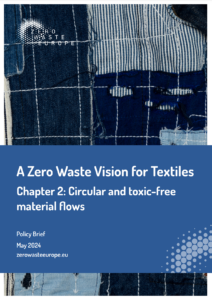

A Zero Waste Vision for Textiles – Chapter 2: Circular and toxic-free material flows
This second chapter of our two-part series on textiles sketches out what a truly circular and toxic-free system for textiles looks like. The report investigates the current barriers to circularity, identifies solutions, and makes recommendations for policy measures in the EU.
The European textile sector, characterised by its staggering waste generation and significant environmental impact, is at a crossroads and requires immediate action to transition towards the circular economy. Key challenges include the environmental impact of production and health risks for consumers posed by the use of harmful chemical substances, fossil fuel-based synthetic fibres, and the release of microplastics. Furthermore, the low rates of local reuse, repair, and upcycling of textiles as well as the insufficient separate collection capacity hamper circularity.
Another significant obstacle is the insufficiency capacity for recycling in Europe; operations are often not economically viable due to a lack of design for recycling, investments in technologies for closed-loop recycling, but also the slow uptake of recycled content. Finally, the negative social and environmental impacts of exported second-hand textiles pose a huge challenge to regulators.
In the first chapter of this two-part series, ‘A Zero Waste Vision for Fashion – Chapter 1: All We Need Is Less’, we outlined that without a shift to sufficiency in the fashion sector, the industry is on track to exceed several planetary boundaries.
Executive Summary available in English.
Full paper available in English.